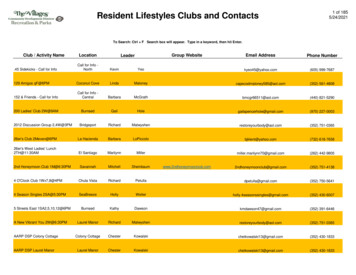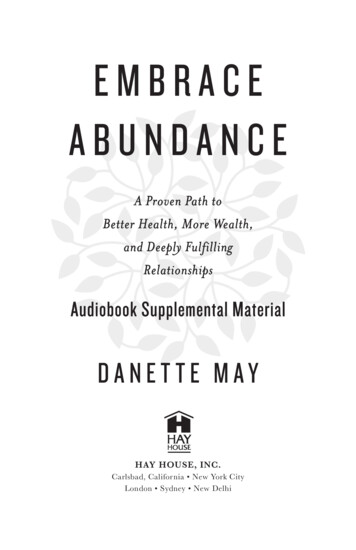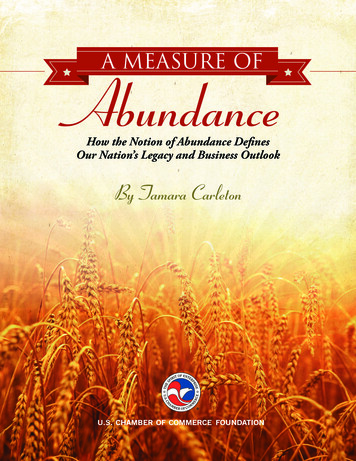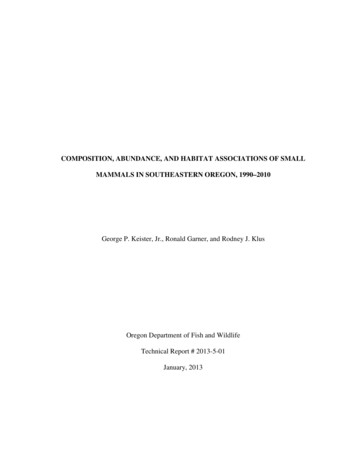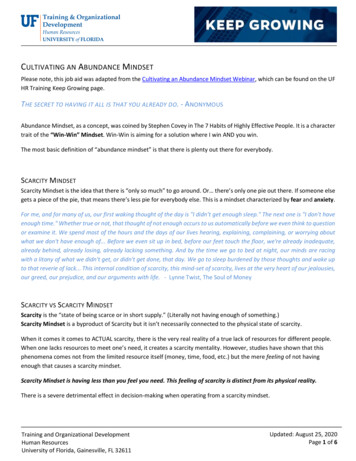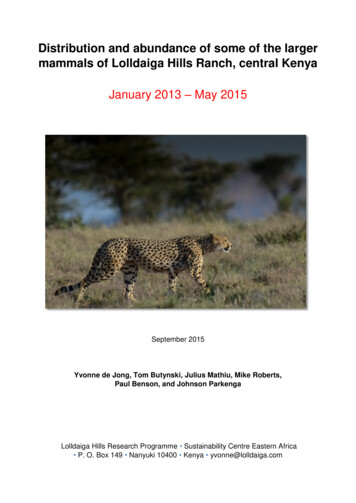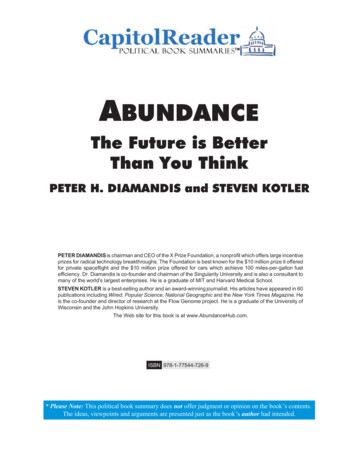
Transcription
ABUNDANCEThe Future is BetterThan You ThinkPETER H. DIAMANDIS and STEVEN KOTLERPETER DIAMANDIS is chairman and CEO of the X Prize Foundation, a nonprofit which offers large incentiveprizes for radical technology breakthroughs. The Foundation is best known for the 10 million prize it offeredfor private spaceflight and the 10 million prize offered for cars which achieve 100 miles-per-gallon fuelefficiency. Dr. Diamandis is co-founder and chairman of the Singularity University and is also a consultant tomany of the world’s largest enterprises. He is a graduate of MIT and Harvard Medical School.STEVEN KOTLER is a best-selling author and an award-winning journalist. His articles have appeared in 60publications including Wired, Popular Science, National Geographic and the New York Times Magazine. Heis the co-founder and director of research at the Flow Genome project. He is a graduate of the University ofWisconsin and the John Hopkins University.The Web site for this book is at www.AbundanceHub.com.ISBN 978-1-77544-726-9* Please Note: This political book summary does not offer judgment or opinion on the book’s contents.The ideas, viewpoints and arguments are presented just as the book’s author had intended.
Abundance - Page 1MAIN IDEAWhen you examine all the hard facts, the science and engineering which are now in the pipeline, the only feasible conclusion one canreach is the world is on the cusp of major marketplace changes. Exponential increases in technology mean within the next twodecades, the world (both developed and developing nations) will have the capacity to meet and exceed the basic needs of every man,woman and child on the planet. Abundance for all is literally within our grasp and a rising global living standard will result.While this may run contrary to the gloom and doom which fills the daily news cycle, the undeniable fact is exponential gains are nowbeing made in a wide and growing number of fields – artificial intelligence, robotics, computing, broadband networks, digitalmanufacturing, nanomaterials and synthetic biology to name just a few. As these and other technologies mature and get applied, it isinevitable society’s most unsolvable problems will be addressed, especially when all of these advances amplify and build on eachother.“For the first time in history, our capabilities have begun to catch up to our ambitions. Humanity is now entering a period of radicaltransformation in which technology has the potential to significantly raise the basic standards of living for every man, woman, andchild on the planet. Within a generation, we will be able to provide goods and services, once reserved for the wealthy few, to any andall who need them. Or desire them. Abundance for all is actually within our grasp.”– Peter Diamandis and Steven Kotler1. How do you define abundance? . . . . . . . . . . . . . . . . . . . . . . . . . . . . . . . . . . . . . . . . . . . . Page 2Abundance is best described as a three-tiered pyramid where first basic needs are met, then the personhas access to the tools of growth and finally they live healthy and free lives where they can contribute tosociety. Abundance will be realized when everyone on the planet has unfettered access to all three tiers.2. Exponential technologies now coming into play . . . . . . . . . . . . . . . . . . . . . . . . . . . . . . . . . . . Page 3It’s hard for the human mind to comprehend the power of exponential technologies. The underlying driverof growth, however, is the fact at the present time, a number of technologies are enjoying exponentialgrowth for a variety of reasons. All of that growth has the potential to change the world, especially when thecumulative impact of those advances are considered.3. Building the base of the pyramid . . . . . . . . . . . . . . . . . . . . . . . . . . . . . . . . . . . . . . . . . Pages 4 - 5To build the bottom layer of the pyramid and bring food, water and shelter to all, those exponentialtechnologies are going to need a bit of help. Fortunately, there are already forces already at play which willaccelerate the impact of those exponentials. In the next two- to three-decades, these three forces willcombine and collaborate to speed up progress on building the base of the abundance pyramid:1. The do-it-yourself innovators2. The arrival of a new breed of technophilanthropists3. The combined power of the one billion emerging consumers4. The peak of the pyramid . . . . . . . . . . . . . . . . . . . . . . . . . . . . . . . . . . . . . . . . . . . . . . Pages 6 - 7Once everyone has enough water, food and shelter, then further progress is defined and driven by theiraccess to energy, education and healthcare. Abundance has to be all-inclusive to be sustainable. Oncepeople have those resources, they then start working on increasing their personal freedoms. Freedom isthe direct beneficiary of progress.5. Steering towards a faster course of action . . . . . . . . . . . . . . . . . . . . . . . . . . . . . . . . . . . . Pages 7 - 8One of the best ways to move progress towards abundance forward faster is to run some incentivecompetitions which will reward those who get there first. This is a device which has worked to stimulatemankind’s progress in the past and incentives have a solid track record. To bring about abundance,society needs to set more bold targets and then reward those who get there first with the solutions that willbe required.
Abundance - Page 21.How do you define abundance?Abundance is best described as a three-tiered pyramid wherefirst basic needs are met, then the person has access to the toolsof growth and finally they live healthy and free lives where theycan contribute to society. Abundance will be realized wheneveryone on the planet has unfettered access to all three tiers.Health& freedomEnergy, education,access to informationand communication toolsFood, Water & ShelterAbraham Maslow created what he termed his “hierarchy ofhuman needs” in the 1950s and this working definition ofabundance is loosely based on an adaptation of Maslow’sconcept. For an abundance pyramid:nnnThe base of the pyramidGlobal abundance would mean first of all everyone hassufficient water, food and shelter. Or to be specific: Three to five liters of drinking water per day per person. 2,000 calories or more of balanced, nutritious food daily. Vitamin and mineral supplements as required. 25 liters of water per person per day for bathing, cooking, etc. Durable shelter with lighting, ventilation and sanitation.The middle level of the pyramidOnce basic survival needs are met, people then want accessto energy, education, information and communication tools.These dictate one’s standard of living and provide the meansfor people to specialize in what they choose to do and then tobe able to sell or exchange what they produce. Improvementsfor the people of the world in all of these areas would havehuge benefits for society at large.The peak of the pyramidAbundance must be all-inclusive. Preserving and providingfor the good health of the planet’s population and theelimination of preventable deaths is an obvious and essentialpart of any definition of abundance. So too is freedom orpolitical liberty – people being free to make choices and to actupon their own preferences.So what is a reasonable time-frame for reaching these targets?Abundance is achievable within the next twenty-five years – by2035. As “ambitious and far-fetched” as that may seem circa2012, the simple dynamic is within the next decade significantand noticeable exponential changes will occur worldwide.Few people believe global abundance will come about in theirlifetimes. The reasons so few people believe in that possibilityare numerous:nEvery day, you’re deluged with news about pandemics,terrorists, regional conflicts and worse. That gives theimpression worthwhile advances are completely out of reachand unrealistic.nThe news media has a bias towards negative news whichsells better than good news. It’s in their best interest tooveremphasize the bad and therefore you believe “we’re in ahole which is too deep to climb out of.”nThe average person today is exposed to more newinformation in a week than a person in the seventeenthcentury encountered in a lifetime. It’s hard to make sense ofthat much stuff – so you assume the worst.nGenerally speaking, society’s pessimists get more air timethat society’s optimists. When people make predictions aboutfamine and pestilence, you pay more attention than someonewho suggests great things are about to happen.The simple fact is today, less people are living in abject povertyand back-breaking destitution than at any time in the history ofEarth. The number of people living on less than 1 a day hashalved since the 1950s and today accounts for less than 18percent of the world’s population. Even better, that number isdeclining at an increasing rate. Political liberty and civil rightshave increased substantially in the past decades with practiceslike slavery being outlawed. Social scientists also point outviolence is decreasing as incomes rise.Simply put humanity has covered a considerable stretch ofground over the last few hundred years but that growth will seemtame by comparison with what will be achieved in the nexttwenty-five years. Some great new tools and technology arenowo coming into play. The concept of global abundance isn’t amirage in the distance – it is something which is reasonable toachieve.“A large proportion of our high standard of living today derivesnot just from our ability to more cheaply and productivelymanufacture the commodities of 1800 but from our ability tomanufacture whole new types of commodities, some of which doa better job of meeting needs that we had back in 1800, andsome of which meet needs that were unimagined back in 1800.”– J. Bradford DeLong, economist,University of California at Berkeley,“Despite the disparities today, we have seen two hundred yearsof enormous progress. That huge historical gap between theWest and the rest is now closing. We have become an entirelynew, converging world. And I see a clear trend into the future.With aid, trade, green technology, and peace, it’s fully possiblethat everyone can make it to the healthy, wealthy corner.”– Hans Rosling, professor of international health,Karolinska Institute (Sweden)“History’s littered with tales of once-rare resources madeplentiful by innovation. The reason is pretty straightforward:scarcity is often contextual. Imagine a giant orange tree packedwith fruit. If I pluck all the oranges from the lower branches, I ameffectively out of accessible fruit. From my limited perspective,oranges are now scarce. But once someone invents a piece oftechnology called a ladder, I’ve suddenly got new reach.Problem solved. Technology is a resource-liberatingmechanism. It can make the once scarce the now abundant.Take sunlight, for example. The amount of solar energy that hitsour atmosphere is 174 petawatts (1.740 10 17 watts), plus orminus 3.5 percent. Since humanity currently consumes about 16terawatts annually (going by 2008 numbers), there’s over fivethousand times more solar energy falling on the planet’s surfacethan we use in a year. Once again, it’s not an issue of scarcity, it’san issue of accessibility.”– Peter Diamandis and Steven Kotler
Abundance - Page 32.Exponential technologies now coming into playnDigital manufacturing and infinite computing3-D printers are now available which build physical objects bylaying down successive layers of materials such as plastic,glass, steel, titanium, etc. Today 3-D printers are being usedto make everything from lamp shades to customizedprosthetic limbs. Hobbyists are making their own robots,biotech firms are experimenting with the 3-D printing ofreplacement organs and astronauts print the spare parts theyneed to make repairs. When 3-D printing combines withongoing exponential increases in computer processingpower, impressive possibilities open up. In the future, insteadof waiting for a retailer to send you something you purchaseby FedEx, you may be able to hit print and make it withinminutes. Digital manufacturing and cloud computing will berevolutionary in their impact because they will be accessibleby all.nMedicineLab-on-a-Chip technologies now under development mean aperson can place a drop of blood on a device sensor andimmediately be screened for a huge database of diseases.This kind of diagnosis will be accurate, low-cost, easy-to-useand quick – perfect for the sixty percent of the world’spopulation which currently lives beyond the reach of urbanhospitals and medical infrastructures. Medicine will movefrom being reactive and generic to more of a predictive andpersonalized delivery model. And the possibilities when AI isadded in become even more interesting.nNanomaterials and nanotechnologyNanotechnology involves building things one atom at a time.Nanoscience will result in materials (nanocomposites) whichare stronger than steel for a fraction of the cost.Nanomolecules will boost the power efficiency of all kinds ofdevices and be used in everything from superconductors todrug delivery systems. Not only will nanotechnology bringaccelerated development to human performance but it willalso have a starring role to play in advances which will come inmaterials, water, energy and food.It’s hard for the human mind to comprehend the power ofexponential technologies. The underlying driver of growth,however, is the fact at the present time, a number of technologiesare enjoying exponential growth for a variety of reasons. All ofthat growth has the potential to change the world, especiallywhen the cumulative impact of those advances are considered.In 1990, the US Department of Energy and the National Institutesof Health launched the Human Genome Project. It was forecast itwould take fifteen years and more than 10 billion to sequencethe human genome. Ten years later, Craig Venter decided to getinto the race and established a company called Celera. Bybuilding on the work which had been done by that stage, Vetnerwas able to deliver a fully sequenced human genome in less thana year for just under 100 million (while the government endedup spending 1.5 billion.) This illustrates the fact whenexponential changes occur – like that which has happened withraw computing power – it’s difficult to forecast just how quicklysignificant change can come about.Increases in computing power is the not the only field in whichexponential changes are occurring. Other fields which areenjoying exponential growth also include:nnnnBioengineeringThe search is on today for algae-based fuels which canreplace petroleum with fuel that is ultra-low-cost andenvironmentally friendly. Bioengineering has also meant foodcrops that are fifty times more productive, vaccines that canbe made in twenty-four hours rather than months and othernatural process enhancement technologies.Networks and sensorsWhile the Internet has created what is in effect a global datafield, it’s still early days yet. In the very near future, trillions ofdevices will be connected in. That will enable companies tomatch production with demand with decimal point precisionand for devices to be operated in such energy efficient waysthe savings in energy use will be world changing. The worldwill be awash with so much real-time information almost everyindustry imaginable will be reinvented.Artificial intelligenceFor all its false starts and hyped promises, artificialintelligence is steadily gathering momentum and operationalcapabilities. This will soon lead to anti-collision sensors formotor vehicles which will not only save lives but alsosubstantially reduce the world’s 230 billion annual accidentcosts – around 2 to 3 percent of the world’s GDP. AI willrevolutionize the way children are taught in the future, the waypatients are diagnosed and the way energy gets used.RoboticsWithin a few short years, personal robots will take over thecare of the young and the elderly, the productivity of factoriesand many other time intensive tasks. As these efficiencieswork their way through the economy, the global economy willgrow by orders of magnitude and many important challengeswhich are now facing different nations will be addressed. Thepossibilities which open up when everything imaginable isautomated are hard to comprehend.What all this means is as impressive as the pace of technologicalchange in the world has been thus far, we haven’t seen anythingyet. When all of these technologies which are growing atexponential rates get combined, greater progress will be made inthe future than ever before. The current rate of technologicalprogress is moving more than fast enough to solve the challengeof creating abundance for all.“I now have a very simple metric I use: are you working onsomething that can change the world? Yes or no? The answerfor 99.99999 percent of people is ‘no.’ I think we need to betraining people on how to change the world. Obviously,technologies are the way to do that. That’s what we’ve seen inthe past; that’s what drives all the change.”– Larry Page, cofounder, Google“Ultimately, though, the most exciting development will be wheninfinite computing is coupled with 3-D printing. This revolutionarycombination t horoughly democratizes design andmanufacturing. Suddenly an invention developed in China canbe perfected in India, then printed and utilized in Brazil on thesame day—giving the developing world a poverty-fightingmechanism unlike anything yet seen. “– Peter Diamandis and Steven Kotler
Abundance - Page 43.Building the base of the pyramidTo build the bottom layer of the pyramid and bring food, waterand shelter to all, those exponential technologies are going toneed a bit of help. Fortunately, there are already forces alreadyat play which will accelerate the impact of those exponentials. Inthe next two- to three-decades, these three forces will combineand collaborate to speed up progress on building the base of theabundance pyramid:1. The do-it-yourself innovators2. The arrival of a new breed of technophilanthropists3. The combined power of the one billion emerging consumersOne of the great features of biological systems is individualentities can work together toward a greater cause. This iscertainly true for the human race where cultural evolution occurson a regular basis along these lines:trials in Bangladesh, a Slingshot was run for 6 months by burningcamel dung and in addition to generating fresh drinking water,the machine also provided villagers with enough electricity tocharge their cell phones and power their lights.Admittedly the Slingshot still costs 100,000 each but withvolume production, the cost per unit will come down to 5,000.The Slingshot is designed to work for at least five years withoutany maintenance so that means the cost of producing onethousand liters of drinking water per day is 0.0002 per liter.Allowing for interest and labor, that will work out to four cents forfive liters of drinking water.As promising as the Slingshot sounds, it will only be one part ofmaking water universally available. Engineer Michael Pritchardhas developed the Lifesaver bottle which incorporates amicrofilter. A family-sized version produces 25,000 liters of waterfor half-a-cent per day. For total capital expenditure of 20 billion,everyone on the planet can have access to safe drinking water –and many more nanotechnology devices and filters are on theway which will work even better and even cheaper.1A new technology comes alongwhich enables people to specialize2As people specialize, they become betterequipped to collaborate with othersHealth& freedom3As people work together, newcapabilities are developed4Those expanded capabilities can then begrafted into next generation technologiesEnergy, education,access to informationand communication toolsIn this way, a self-perpetuating positive feedback cycle startsand grows. This kind of feedback cycle is now starting to come tobear on the challenge of providing everyone on the planet withenough food, water and shelter. Some very smart people areturning their attention to this and they have two of the mostpowerful tools of collaboration and cooperation at their disposal:1. Modern transportation capabilities – which makes it feasiblefor physical items to be delivered anywhere in the world costeffectively.2. Information and communication technology – like cellphones and the Internet which makes it possible for mentalresources from all over the world to get organized andsynchronized.Food, Water & ShelterImpressive advances are also being made in meeting thechallenge of feeding the world’s population. Traditional farmingand food production methodologies have used pretty much a“brute force” approach which is clearly unrealistic for developingnations. Genetically engineered crops have resulted in aneighty-seven fold increase in productivity and haverevolutionized food production but distribution still remains achallenge. The fact is despite living on a planet which producesmore than enough food for everyone, there are nearly one billionpeople who currently go hungry. Several innovative solutions tothis dilemma are under development:nHydroponics – growing food in water rather than soil – is 70percent more efficient than traditional soil-based agriculturebut to date has only been used in small niche applications likegrowing pot or recreational drugs. In 1983, NASA researcherstrying to figure out how to feed astronauts on Mars came upwith aeroponics – suspending plants in midair and deliveringfood to them through a nutrient-rich spray. Aeroponics is 70percent more efficient than hydroponics. Furthermore, sincetraditional agriculture uses 70 percent of the water on theplanet, if aeroponics were to be widely adopted, agriculturalwater use would drop to 6 percent.nOne of the major costs of food is transportation. With that inmind, vertical farms are being developed which can belocated in buildings in major cities. A thirty-story vertical farm,one square New York block in footprint, could grow enoughfood on site to feed fifty thousand people a year. One hundredand fifty vertical farms could feed everyone in New York Citywithout the use of pesticides and with no fossil fuels beingused for planting, harvesting and delivery.Both of these tools are potential game changers in and ofthemselves because they give individuals the ability tounderstand global issues and then do something practical aboutthem. When you have information-sharing devices which areportable, affordable and hooked up to the Internet, prettyimpressive things can come about.Take the challenge of getting drinkable water to everyone, forexample. Around 97.3 percent of the water on the planet is toosalty to drink and another 2.0 percent is locked up as polar iceleaving just 0.5 percent for human consumption, agriculture,industrial uses, etc. Self-taught physicist Dean Kamen, founderof DEKA Research and Development, has developed a machinethe size of a dorm-room refrigerator which allows you to stick theinlet hose into anything wet – salt water, waste water, evenlatrines – and the machine can generate 1,000 liters (250gallons) of completely sterilized drinking water a day. What’seven more impressive is this machine, called the Slingshot, cando that using the same amount of energy as a hair dryer. In field
Abundance - Page 5nEven with ultra-efficient farms, humans still need 10- to20-percent of their diet to be protein. Cattle and chickens are ahighly inefficient way to produce that. Aquaculture (fishfarming) is one promising alternative which is renewable andscalable. The other alternative here is cultured meat or in-vitromeat – where meat is grown from stem cells in giant tanksknown as bioreactors. NASA again pioneered the culturedmeat process in its quest to find ways to feed astronauts onlong space flights. Admittedly all of these technologies haveproblems and issues which must be addressed before theyget to prime time use but they all have the potential to feed theworld in more efficient and therefore more sustainable ways.nAccelerator #2 – The new breed of technophilanthropistsWhen Bill Gates, one of the world’s richest men, left Microsoft,he established a foundation and started working to bring morevaccines to children and others around the world. Rather thanwaiting for the World Health Organization to get onboard,Gates pledged 10 billion of his own money, built a team andstarted getting people on the ground where it counted themost. Even better than the fact he could write checks to fundeverything himself, having Gates involved also opened lots ofdoors that ordinarily would have been shut. Gates is just oneof the new breed of hard chargers who typically earned theirfortunes at young ages in technology ventures and have nowdecided to try and make a difference. In 2010 alone, Bill Gatesteamed up with legendary investor Warren Buffett and gotsixty-nine billionaires to pledge they would give away at leasthalf of their fortunes to charities before their deaths. Those tohave signed up include George Soros, Ted Turner, DavidRockefeller, Larry Ellison, Paul Allen, Steve Case, PierreOmidyar and Mark Zuckerberg. These are smart people whohave amazing resources behind them and they are nowfocusing on solving the biggest problems facing humanity inthe immediate future.nAccelerator #3 – The rising billionThe world’s biggest untapped market is the four billion peoplewho occupy the lowest strata of the economic pyramid. Theso-called bottom billion are now becoming a viable economicmarket for the first time in history because this is a niche thathas extraordinary aggregated purchasing power. Findingways to collaborate with this market in development activitieswhich pull the poor out of poverty is an awe inspiring marketopportunity. As the bottom billion get access to products andservices which are now only available in established maturemarkets, they will become the rising billion. There will be suchlarge advances in their combined purchasing power they willhave the power to dramatically reshape the world. Assmartphones – which have the processing power of thepersonal computers of just a few years ago – becomeavailable at an affordable price to the bottom billion, there willbe a huge influx of fresh ideas which will have the ability totrickle up. It’s not at all unreasonable to conclude theimminent arrival of the bottom billion may yet turn out to be thesaving grace of the entire plant.It will probably take around ten to fifteen years for thesefeed-the-world technologies to penetrate deep into the world’sfood crop markets. In the meantime, genetically engineeredcrops of cotton, corn and soybean will continue to increase.Farmers will figure out better ways to deal with crop loss causedby pestilence by becoming more familiar with push-pullinterlocking systems – where plants which deter insects areplanted between rows of cash crops like corn and soybean. All ofthese developments will improve the planet’s primaryproductivity and make it feasible to feed the world.As promising as all these new food, water and sheltertechnologies sound, there are three other forces of abundancewhich have come along in recent years which will combine toaccelerate progress in all these areas:Health& freedomEnergy, education,access to informationand communication toolsFood, Water & llion123Accelerator #1 – The new breed of do-it-yourself innovatorsMany people today are combining the tools of the informationage with their own self-reliance to do impressive things. Inmany ways, the quality of the tools which are freely availablehave now caught up with the scope of the idealist’s vision.Small groups are getting together (either in person or via theInternet) to pull things off which in previous eras would haverequired the resources of large corporations or even thegovernment of a nation. Small private companies andtalented individuals are now flying into space, buildingautomated drones and developing synthetic biologycapabilities which are truly impressive. Social entrepreneursare banding together to provide finance for third-worldbusinesses and to invest in purpose-driven causes. Neverbefore in history have ordinary people had the ability toachieve so much and many DIY innovators are now applyingtheir skills and talents to the challenges of feeding the world.“As some of the smartest people look at where to focus theirenergies next, they are now attracted to the biggest problemsfacing humanity, particularly in areas such as education, healthcare, and sustainable energy. Without suggesting complacency,I believe it is very likely that they will solve the many challenges inthose areas, and the result will be the creation of newtechnologies, companies, and jobs that will bring prosperity tobillions on Earth.”– Elon Musk, cofounder PayPal“Never before in history has the global marketplace touched somany consumers and provided access to so many producers.The opportunities for collaborative thinking are also growingexponentially, and since progress is cumulative, the resultinginnovations are going to grow exponentially as well. For the firsttime ever, the rising billion will have the remarkable power toidentify, solve, and implement their own abundance solutions.And thanks to the net, those solutions aren’t going to staybalkanized in the developing world.”– Peter Diamandis and Steven Kotler
Abundance - Page 6Food, Water & Shelter2. Education – The long-term benefits of more education areobvious. What’s changing, however, is the traditional modelof a fixed educational system is becoming obsolete. In itsplace are initiatives like One Laptop Per Child – which as itsname suggests is attempting to provide every child on theplanet with a rugged, low-cost, low-power laptop which isconnected to the Internet. The initial goal was to make thisavailable at a 100 price tag and thus far it
Abundance Author: Summaries.Com Subject: The Future is Better Than You Think Keywords: Peter Diamandis, Steven Kotler, Creativity, Technological innovations, Technological forecasting, Social aspects of

